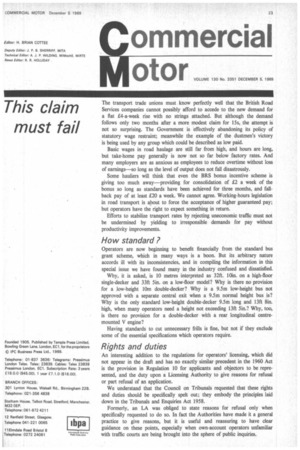omrnercial
Page 25

If you've noticed an error in this article please click here to report it so we can fix it.
otor VOLUME 130 No. 3351 DECEMBER 5, 1969 The transport trade unions must know perfectly well that the British Road Services companies cannot possibly afford to accede to the new demand for a flat £4-a-week rise with no strings attached. But although the demand follows only two months after a more modest claim for 15s, the attempt is not so surprising. The Government is effectively abandoning its policy of statutory wage restraint; meanwhile the example of the dustmen's victory is being used by any group which could be described as low paid.
Basic wages in road haulage are still far from high, and hours are long., but take-home pay generally is now not so far below factory rates. And many employers are as anxious as employees to reduce overtime without loss of earnings—so long as the level of output does not fall disastrously.
Some hauliers will think that even the BRS bonus incentive scheme is giving too much away—providing for consolidation of £2 a week of the bonus so long as standards have been achieved for three months, and fallback pay of at least £20 a week. We cannot agree. Working-hours legislation in road transport is about to force the acceptance of higher guaranteed pay; but operators have the right to expect something in return.
Efforts to stabilize transport rates by rejecting uneconomic traffic must not be undermined by yielding to irresponsible demands for pay without productivity improvements.
How standard ?
Operators are now beginning to benefit financially from the standard bus grant scheme, which in many ways is a boon. But its arbitrary nature accords ill with its inconsistencies, and in compiling the information in this special issue we have found many in the industry confused and dissatisfied.
Why, it is asked, is 10 metres interpreted as 32ft. 10in, on a high-floor single-decker and 33ft Sin. on a low-floor model? Why is there no provision for a low-height 10m double-decker? Why is a 9.5m low-height bus not approved with a separate central exit when a 9.5m normal height bus is? Why is the only standard low-height double-decker 9.5m long and 13ft 8in. high, when many operators need a height not exceeding 13ft Sin.? Why, too, is there no provision for a double-decker with a rear longitudinal centremounted V engine?
Having standards to cut unnecessary frills is fine, but not if they exclude some of the essential specifications which operators require.
Rights and duties
An interesting addition to the regulations for operators' licensing, which did not appear in the draft and has no exactly similar precedent in the 1960 Act is the provision in Regulation 10 for applicants and objectors to be represented, and the duty upon a Licensing Authority to give reasons for refusal or part refusal of an application.
We understand that the Council on Tribunals requested that these rights and duties should be specifically spelt out; they embody the principles laid down in the Tribunals and Enquiries Act 1958.
Formerly, an LA was obliged to state reasons for refusal only when specifically requested to do so. In fact the Authorities have made it a general practice to give reasons, but it is useful and reassuring to have clear guidance on these points, especially when own-account operators unfamiliar with traffic courts are being brought into the sphere of public inquiries.






















































































































































